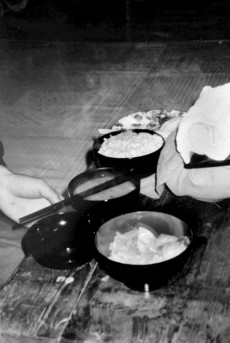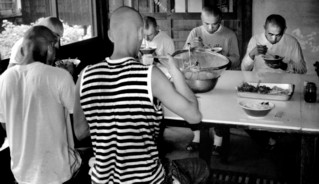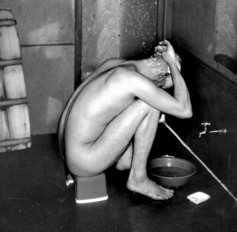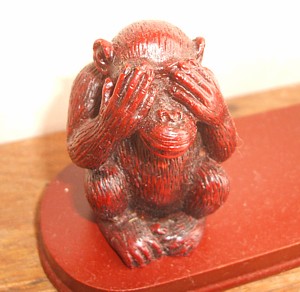Manual for practice

Community Practice
Life at Antaiji is based on shared practice where it is not possible for individuals to make their own schedules. You will be expected to work together with everybody else and perform shared tasks at set times. Please read this booklet, observe and follow what other people are doing, and if you have additional questions ask someone at a suitable time.

Communication
Communication is a central part of shared practice, and not just about what is said. Familiarize yourself with the daily schedule, be observant of whatever is happening and what needs to be done, and - especially if you do not speak Japanese - make an effort to fit in and contribute. As a new arrival, take the opportunity to adopt a beginner's mind and to learn all that you can, including the Buddhist chants and Japanese phrases which are in daily use at Antaiji and mentioned in this booklet.

Zazen and Procedures in the Hondo
At 4am a monk in the role of jikido will run up and down the Antaiji's hallways with a bell to announce the first zazen period. Make sure that you do not stand in the jikido's way, and that you have been awake well before this and are now ready to enter the hondo (Antaiji's sitting hall) without further delay. For this you should be wearing comfortable clothing, but please no socks or hats. If you are cold, bring a towel or blanket to cover your feet. Before you enter the hall, lower your head with your hands in front of your chest beside the jikido who will stand by the hondo entrance, and then do gassho on stepping inside the hondo. When bowing in gassho, bow only from your hips, and keep your back, neck, and legs straight.

Next walk quietly to your allocated sitting place, with your hands held in shashu (if you do not know how to do something, please ask to be shown beforehand). For those whose place is at the far end of the hondo, be sure to walk only around the back of the altar table, rather than in front of it. Should you ever need to leave the hondo to go to the toilet, please only do so between zazen periods during kinhin (walking meditation). Before stepping out of the hondo, turn around and do a gassho facing in. Be sure you get back as soon as you hear the bell ring once, which is the signal of the end of kinhin. When you re-enter the hondo, again do a gassho. Be very quiet throughout.

When you get to your zafu (cushion), before sitting down, first do a gassho toward it, and then, turning clockwise, another one in the opposite direction. Then sit down facing the wall and settle into the correct posture for zazen, preferably kekkafuza (full-lotus) or hankafuza (half-lotus), or otherwise another posture which is sufficiently stable for you and allows you to settle your feet and knees on the zabuton (mat). If you are already seated when one of your immediate neighbours comes and bows before their zafu, raise your own hands in gassho at the same time. When everybody is settled, the jikido will strike the bell three times, which signals the start of the zazen period. During zazen, keep your spine straight and extended, pull your buttocks up and push your lower back forward, and extend your neck by pulling in your chin.

Dogen says of the correct zazen posture:
"Your ears should be kept in line with your shoulders, and your nose in line with your navel. Rest your tongue against the roof of your mouth, and breathe through your nose. Lips and teeth should be closed. Eyes should be open, neither too widely nor too narrowly. Having adjusted body and mind in this manner, take one breath and exhale fully. Sit solidly in concentration and think not-thinking. How do you do this? Let go of thoughts. This is the art of zazen. It is not learning to do meditation. It is the Dharma gate of ease and joy. It is undefiled practice-realization."

During zazen, allow your breath to come and go naturally from your diaphragm rather than from your upper chest, and let go of body and mind. Invariably you will experience pain, boredom, drowsiness, or anger, and all kinds of thoughts. Let them be and go. Unless you sit with a willingness to die, you may just be pointlessly torturing yourself and wasting your time. Do not disturb others, or ever leave your zafu during a zazen period. Do not expect rewards. Just keep awake, maintain your posture, and let your body and mind drop off.

The jikido will end a zazen period by striking the bell twice. After the second strike, raise your hands and bow in gassho, then stand up and again do a gassho to your zafu, and another in the opposite direction. Now start kinhin (walking meditation) in a clockwise direction, making sure that you leave enough space for the person behind you. During kinhin, keep your upper body straight as in zazen, hold your hands together in isshu, and advance by small half-steps with each exhalation, while relaxing your body during inhalations.

Depending on your rhythm of breathing, you can adjust the length of your steps to maintain the same distance between yourself and others. When the jikido strikes the bell once to end the kinhin period, bow where you are with your hands held in shashu, and then follow the person in front of you back to your sitting place. Again do a gassho towards your zafu and in the opposite direction, before settling down on your zafu for the next period of zazen.

After the last zazen period before a meal, or at the end of a day, there is no more kinhin. Following the second zazen period in the morning, before breakfast, there is chanting of the Takkesage (Robe Chant), after which the monks put on the o-kesa:
"DAI SAI GE DAP-PUKU / MU SO FUKU DEN E / HI BU NYO RAI KYO / KO DO SHO SHU JO"

Whenever there is a meal which follows a zazen period, everyone walks from the hondo straight to the hiroma (dining room). Do not first go to your room or to the toilet, unless it is after the last zazen period in the evening.

Please direct any further questions you may have about hondo procedures to the jikido or the monk responsible for guests and new arrivals.

Meals
Breakfast and dinner are taken in the hiroma, except on hosan (free days) when meals are informal and taken in the outer dining room. On entering the hiroma, walk to your allocated place, do a gassho, and then be seated in seiza (kneeling position). Before breakfast, except during sesshin when there is no speaking, say "ohayo gozaimasu" (good morning) together with everyone else before sitting down.

Other than on hosan, all meals begin and end with one and two strikes respectively from wooden clappers, which is a sign for all to bow in seated gassho. Meal chants accompany all meals, except during sesshin and on hosan. In the mornings, chanting is of the complete meal sutra GYOHATSUNENJU, which is included in the book Soto Shu Sutras. At other times, the following shorter chant is used:
"NYAKU ON JIKI JI / TO GAN SHU JO / ZEN ETSU I JIKI / HO KI JU MAN"(start of meal) ;
"BON JIKI I KOTSU / TO GAN SHU JO / TOKU GYO JU YO / JO JU SHU RIKI"(end of meal) .

Most meals taken in the hiroma involve the tradition of oryoki, which is difficult to explain without an actual oryoki set, and so will best be taught to you practically by the monk responsible for guests and new arrivals. The main rule for you to follow whilst you are learning oryoki is to remain aware of what is happening around you, of what is therefore required of you, and to be as speedy and quiet as you can in actually doing it. Do not let others wait for you just because your focus is solely on your own food or whatever else may be happening for you.

An integral part of oryoki is the setting out of the eating bowls, the serving of the food, and the cleaning up after eating. Unwrap your oryoki bowls along with everyone else, and quietly arrange them before you, with the large bowl for rice to your left, the middle bowl for miso soup in the centre, and the small bowl and any other side dishes to your right. Place the setsu (cleaning device) between the two smaller bowls on your right with its cloth end is pointing towards you, and then put the chopsticks between yourself and the bowls with the tips pointing to the right and resting on the setsu.
In serving the food, depending on where you are seated in relation to the serving pots of rice and miso, your role will be either to stay seated and serve others and eventually yourself, or to get up with one of your neighbour's bowls and one of yours, and walk up with them to the relevant serving pot to be served by the person sitting there. As you are being served, kneel down and have your hands raised in gassho. After you have returned to your place, and the bowls are back in their place on the bench, finally place your chopsticks diagonally across the miso bowl.

Eating starts with everyone doing gassho and then lifting their respective rice bowls to their heads. Eat by alternating between your different bowls and side-dishes. With the exception of rice and miso, you may also at any time help yourself to more food from the centre of the bench. To do so, put down the chopsticks pointing to the right, and bow in gassho before and after you serve yourself. About halfway through the meal, the abbot will put down his chopsticks, which is a signal for everyone to do likewise and then bow in gassho, before helping themselves to seconds of rice or miso. Be sure to take only as much food as you can finish in time with everyone else without any leftovers in your bowls.

When all your bowls are empty, again place your chopsticks diagonally across the miso bowl. Then do a gassho, raise your chopsticks to your mouth, and clean the ends with your lips while covering your mouth with your other hand. Put the chopsticks down on the bench, but now pointing to the left, and next pick up the setsu and proceed to clean your bowls and side-plates with it, starting from the left. When this is done, place the setsu into your first bowl, with the handle at right angles to the bench and pointing away from you. Wait until all have finished, then bow in gassho with everyone else, and help in carrying everything, except for the oryoki bowls, from the bench to the kitchen.
Quickly return to your place, and if it has not already been done, put the water kettle, green bucket, and cloth from beneath the bench on top of it. Each kettle, bucket, and cloth will be for use by a group of four, and depending on whether you are sitting on the same or opposite side to the abbot, you will either be served hot water or have to serve it to the person opposite you. If you are to be served, bow in gassho at the same time as your opposite, then take your first bowl and hold it with your left hand so that your opposite can pour water into it. Meanwhile hold your setsu in your right hand, with its cloth tip pointing towards yourself, and move it slightly upwards when you have enough water in your bowl. Place the bowl, with the setsu inside it, back on the table, and wait for your opposite to serve himself, before all in your group of four should bow in gassho. The person holding the kettle should bow in such a way that the kettle is raised to about head-height, and then pass it on to the person next to him, who in turn bows to and serves the person opposite. Once all in the group of four have received their water, the kettle is put back under the bench.

Using the setsu, start by cleaning the first bowl on the inside while keeping it on the bench, then pour the water into the second bowl wherein you can clean the outside rim of the first bowl. Dry the first bowl using the white cloth, put it back on the table, and put the white cloth inside it. Clean the chopsticks with the setsu inside the second bowl, then dry them, and place them on the bench pointing towards you. Clean the second bowl first on the inside, then pour the water into the third bowl, and also clean the outside. Dry the second bowl, and quietly place it inside the first bowl, and again put the white cloth inside. Now clean the setsu in the third bowl, dry it, and place it on the bench beside the chopsticks, with the cloth end pointing towards you. Bow in gassho and pour the water from the third bowl into the green bucket, pouring very quietly and towards yourself. If you are the last of your group of four to have done so, subsequently take the bucket and put it back under the bench. You may drink any remaining water from your third bowl, then dry it, and place it inside the other two bowls. Spread out the wrapping cloth diagonally on the bench, wrap up the bowls, and place the chopsticks and setsu on top, covered by the white cloth. Raise your hands in gassho, before tying up your clean oryoki set.




Do another gassho, then raise up your oryoki set, and with the wet folded cloth that is on the bench, wipe down the bench before you. Turn over the cloth, or if previously turned over, refold it inside out, so that the person using the cloth after you gets a clean side. When everyone has finished, the clappers will be struck twice, all bow in gassho, then quickly stand up with the oryoki sets and bow again with the oryoki set held up at head-height. If you are standing on the side of wall, hand your oryoki set over to the person facing you, or in the other case receive their oryoki set, and do another gassho, before returning the oryoki sets to their shelf above the doorway to the kitchen, and putting away the kettles and buckets, as well as the benches.
Unlike the formal meals in the hiroma, lunches are more informal and eaten in working clothes in the outer dining room, except during winter when that area gets too cold. Lunches usually consist of noodles and tempura. Walk up to where there is a free spot for you to sit, do a gassho, sit down, and follow the others in the way you eat your noodles, making sure that you finish at the same time as everyone else.

Food at Antaiji is mostly vegetarian, but not always. It is not possible for you to have your own meals based on a special diet. You have to eat everything on your plates and in your bowls.

Following all meals, immediately proceed to wash up and dry the dishes and otherwise clean up after the meal. Following breakfast only, the tenzo takes care of cleaning up, so that everyone else can quickly change their clothes and without delay start doing soji (house cleaning).

Soji
Soji usually involves the cleaning of all wooden floors by sweeping them with brooms, and then wiping them with wet cloths. Other tasks may include vacuuming the hiroma, cleaning of the windows, cleaning the hondo, library, toilets, etc. Someone will show you where and how to clean. Do so silently, swiftly, and aware of what you are doing and what needs to be done. When one task is done, see what else may need cleaning. Do not leave brooms standing on their bristles, and make sure you put all things back in their right place when you are finished. Following soji, you will usually have enough time to go to the toilet and brush your teeth before the morning tea meeting and samu (work practice).

Samu
Practice at Antaiji would not be sustainable without samu. But rather than being only a means to an end, samu is itself part of our practice, and like everything else should be approached wholeheartedly. It includes agricultural work, the sourcing of firewood, and ongoing maintenance of the building, property, and surrounding land. The schedule for samu is dependent on the season, as well as on the weather of the day.

The abbot will usually first announce samu at the previous night's tea meeting, and then allocate jobs during the morning tea meeting. At the morning tea meeting, make sure that you are already in your work clothes, and ready to start samu immediately after the meeting. Sometimes you may need to wear wet weather clothes and rubber boots, preferably your own. When you return at the end of samu, always greet the tenzo with the phrase "otsukare-sama desu" (I appreciate your work / fatigue), and tidily put away your boots on the shelf by the entrance.

Tea Meeting
Tea meetings are normally held in the morning and evening on samu days and just in the evening on hosan and the last days of sesshin. They are an occasion to announce and review the business of the day. Morning tea meetings are relatively informal and held in the outer dining room just before samu to discuss and allocate the day's work. Evening tea meetings are more formal and held in the hiroma, usually immediately after the washing up of dinner dishes. On hearing the clappers, go to your allocated position in the hiroma and bow in gassho to the person opposite you, before sitting down in seiza in line with those next to you. Should your opposite arrive later than you, raise your hands in gassho once more when they do. One person will go around and serve tea to everyone. When they come to your place, you and your neighbour should bow in gassho, then take a cup from the serving tray. When doing so, it is good manners to hold your free hand under the tray's edge as if to support it. With the cup held in your hands, exchange another bow with the server, and then put down your cup before your knees in line with your neighbours' cups. If you are the last person to be served on the left side of the abbot, take two cups and put one to your left before the place where the server will sit. Bow in gassho together with everyone else, then raise your cup of tea with both hands and begin drinking it. Again with everyone else, put your cup down to allow for a second serving. The tea kettle will be passed around. In receiving it, raise your hands in gassho, if you wish to have more tea pour some into your cup, and then pass the kettle on to your left. After the second serving, do not pick up your cup, but bow with everyone, this time without raising your hands in gassho, and follow the discussion of the day's events and the plan for samu for the next day. If you have something to say, bow before and after you do so. At the end of announcements, do another gassho with everyone else, and finish drinking your tea before the server comes around again to collect your empty cup. Raise your hands in gassho before and after you return your cup on the serving tray. Wait until the server has left the hiroma, then get up and help with washing up the cups in the kitchen. Unless it is hosan, next prepare yourself for evening zazen.

Bathroom and Toilets
Showering and bathing usually take place in the afternoon, after samu is finished and the bathroom has been prepared and the water heated. You will be told by the tenzo, typically with the phrase "ofuro dozo" (the bath is ready), once the bathroom is open for use. If you have not used a Japanese bath before, please receive instructions about correct bathroom manners. Before entering the change room, check the wooden sign beside the door to be sure that the bathroom is not currently being used by other sex. Inside the change room, always first do sanpai (three prostrations) facing the wooden altar board above the shelves, and then proceed to undress and enter the bathroom.
As you enter the bathroom with your wash towel, say "shitsurei shimasu" (excuse me, but please allow me to enter). If someone else enters after you, respond by saying "osaki desu" (excuse me for already being here). When showering, do not leave the shower running continuously as this will use up the limited hot water. Only use it to wet yourself and rinse yourself off. On days when the bathtub is able to be used, always wash and rinse yourself first so that you are completely clean before you enter the tub. Obviously do not stay inside the tub for too long if someone else is waiting to use it. Otherwise keep the tub covered to minimise heat loss. When you wish to exit the bathroom, say "shitsurei shimashita" (excuse me for leaving), and if someone else leaves ahead of you, respond by saying "otsukare-sama deshita" (have a good rest). Before leaving the change room, again do a sanpai toward the bathroom altar.

Be judicious about when you go to the toilet to avoid making others wait for you. The same toilets are for use by both sexes. Before entering, and after leaving, the room with the toilets and urinals, always bow in gassho to the small altar beside the door. Notice that there are two towel rails, one for personal towels, and the other with towels for communal use. When entering and leaving the toilet area, be especially aware that you close every door behind you to prevent flies and mosquitoes migrating throughout the building.
Laundry
You will find two washing machines and washing powder located in the change room to the bath. Please seek instructions on how and when to use the washing machines. When your items have been washed, empty them from the washing machine and use the upstairs drying room to hang them up to dry.

Library, Photocopier, and Telephone
Antaiji has a library which has books in Japanese, as well as some in other languages. Some of the very old books are kept inside cupboards behind glass doors which should not be opened because the books will deteriorate if exposed to humidity. The library also has a photocopier which is available for limited use. Before you borrow any books or use the photocopier, please consult the monk responsible for the library or the monk responsible for guests and new arrivals, to find out about the borrowing procedures and the correct way of operating the photocopier and paying for any copies that you make. There is also a telephone, which is located in the hiroma and available for common use, provided you do so at a time and in such a way that it does not interfere with the daily schedule or any of your responsibilities. Again, before making any calls, please check on when and how to do it, and how to pay for it.

Responsibility
As a new arrival to Antaiji, you obviously cannot be held responsible for all that happens here. Yet from the outset it is, and will always remain, only your responsibility to make yourself aware of all that you should know. Or have you come here to say, after one week or many months, "I did not know because nobody told me so"?

Just like the experience that you will find at Antaiji will be nothing other than your life, and therefore your responsibility, so your physical and mental health while staying here is nobody else's responsibility but your own. Although you will be expected to take part in all activities and to live harmoniously with the other practitioners at Antaiji, there will not really be anyone to push you forward or pull you back. You will very much be left to yourself in your practice. Make sure you are clear about why you have come here and that there will always only be something to give up and nothing to take away.

"Heaven and Earth give themselves. Air, water, plants, animals, and humans give themselves. It is in this giving themselves to each other that we actually live."
